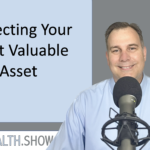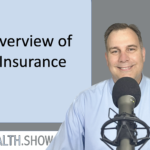Today I want to talk about personal auto insurance, the coverages of it, And where to get it as a reminder, insurance is one of our two rails that protects our wealth.
As we start to get into the path to financial success, how we intentionally build well so that we can retire with confidence. It’s important to remind that The insurance is the defensive side of the game. Doesn’t matter how many points we can put up on the offensive side. If we don’t protect ourselves, the score can be neutralized and our wealth can be dissipated in a very short time, literally in an instant.
And so that’s why we have insurance to protect ourselves.
Now, when it comes to auto insurance, what a lot of people think is that if they have the state minimums, that’s enough coverage. And that is true in that it’s enough coverage to be legal to drive in that state, but it might not be enough coverage to protect yourself from a wealth building perspective.
So for example, each state has a different level. And so this is the state of Virginia as we used to live in Virginia. And you can see here in the Virginia statute, 46. 2 slash four 27, that A driver in the state of Virginia must have at least 30, 000 of bodily injury per person, 60, 000 per accident, and 20, 000 of personal property liability.
But again, that’s enough to be legal in the state of Virginia and each state will be different, but it’s not necessarily enough to adequately protect yourself. And that’s what I want to talk about in this episode. Now, just like with homeowner insurance that we unpacked previously, there’s a deductible.
The deductible is the amount of money that you pay out first before the insurance company will ever put out any payment. So, you can set this as low as normally 250 or as high as a couple thousand dollars. It’s going to depend on your situation. But again, this is where things to start intertwined. The more of an emergency fund you have, the higher the deductible can be and the lower the premiums.
The lower, the deductible, the higher the premiums, right? So, it’s an inverse relationship there. If you have that starter emergency fund of a thousand dollars, you can set that deductible at a thousand dollars, which will help save you some on premiums. Now let’s talk about the actual coverages of premiums.
of auto insurance. The first one is bodily injury. So, this is a liability coverage, which means it’s not really to protect you. It’s protected the damages that you cause to others.
So, let’s say that we get in an accident and it’s my fault. I have caused the accident due to negligence or just an accident or wasn’t paying attention or whatever. And I caused bodily injury to you. Well, my insurance would cover you. My insurance, this part of the section of the insurance of bodily injury isn’t meant to protect me.
It’s meant to protect the injury that I do to others. So. If you go to the hospital and through surgeries and rehab and various things like that, if you have a hundred thousand dollars of medical bills, if I just have the state minimum of Virginia, my insurance company would only pay 30, 000 and then I would be on the hook to compensate you for the other 70.
And so, you know, again, you don’t have a lot of money. This can be a problem. So generally, in that area, what we do is we recommend you have 300, 000 per person. Now let’s say for example there’s, there’s also a limit practice. So as a per person and per accident. So, let’s say for example, we get an accident and.
You and your spouse and your child are in the car, and I do a hundred thousand dollars of damage to each of you So that’s three hundred thousand in total. Well again, Virginia just using that example would say I have to have 60, 000 of total bodily injury liability coverage. So, if each of you had a hundred thousand dollars of liability Expenses, medical expenses.
That means as total of 300, 000, my insurance would only pay 60, 000. It wouldn’t pay 30 per person. It would cap out at 60. And then I would be responsible for the other 240, 000 of coverage. So, with bottle injury, there’s two limits. There’s a per person and per accident. And so generally we recommend 300, 000 per person.
500, 000 per accident. It’s a half a million dollars coverage. That would cover a lot of medical expenses. You know, just think of a life flight, for example, that alone, the helicopter ride for maybe 15 minutes could cost 30, just to get a person to a hospital. So bodily injuries could pile up very, very fast.
The second number that’s associated with liability coverage is that of property. So again, if we get an accident and it’s my fault, this part of the insurance will protect property, not people, but property. So, if I do damage to your vehicle, this, my insurance will cover it. My insurance, this section would not cover my vehicle.
It would cover your vehicle because I caused the accident. Or if it’s a single accident, I go off the road and I hit a structure or a or a property and I do damage to buildings, this would cover that. So again, using Virginia as an example the state law requires only 20, 000 of property liability coverage.
Well, if you hit a Tesla or BMW or Mercedes and you total it, you could very easily do 50, 60, 70, 000 worth of structural damage. And so again, it would be not enough coverage in my opinion. And so, we recommend here to have somewhere between 50 and 100, 000 of coverage. Now there’s also the idea of uninsured motorist coverage, uninsured liability motorists essentially protect me.
So, if we get an accident, and it’s your fault and you caused the accident, but you don’t have insurance. Well, your insurance was supposed to compensate my bodily and property damages, but if you don’t have insurance, then there’s nothing there. I could sue you for the damages that you’ve incurred, but. If you don’t have any money, I’m not going to get anything.
So uninsured motorist is when my insurance will cover me in case the fact that you don’t have proper insurance. Normally those limits are set at the exact same amount. So those are the liability coverages. But again, just as a reminder, those are to protect other people. The damages that you do to other people, nothing that we’ve talked about other than the uninsured protects other people.
Your vehicle or you. So, there’s two other types of coverages that most people would consider having. And that is collision. So, collision is when you collide with something and, it covers the cost to your vehicle. So, let’s say I’m driving and it’s icy and slippery and I go off the road and I hit a tree.
Well, I caused that accident. There was nothing else involved as a single car accident. If I don’t have collision insurance, then. My insurance payment won’t protect that, and I would have to pay for the damages done to my car. If I have collision, this section, this coverage will then protect and compensate me to the damage that I caused to my vehicle.
So, this will basically cover anything that you impact an object other than an animal. An animal is different for some reason. I don’t know why, but it just is. So, Again, if you have a very expensive car, it might make sense for you to have, if you have a 30, 40, 000 car, it might make sense. If you have a 2, 000 car or a 500 car might not make sense to have collision because if you collide with something, you might just junk the car and get a new one.
Comprehensive then is when, when people say I have full coverage, this is kind of what they’re talking about. Comprehensive. Comprehensive covers damages caused by something such as hail. theft, or the collision with, with an animal.
So, if you hit an animal or an animal hits you, you hit a deer, things like that, this part of the insurance would protect your vehicle. And so again, if you have a very expensive car, it might make sense to have.
This is kind of where it depends on what type of car you’re driving. Now, insurance companies then will add on a whole bunch of another variable.
You know, minimal coverages of things, things like roadside assistance, towing, car rental things like that. My clients, this isn’t something I recommend them having just because the amount that they pay all the time for the one instance, a year or a decade when they need it.
It’d been cheaper to just pay for the towing that day, a bunch of limitations and stuff with those coverages. But if you make you feel better having them, you can certainly do that.
We’ll address where to purchase on insurance. And just like with homeowners, there’s really two different ways.
You can go directly to an insurance company. nationwide, all state USA Geico, et cetera. And again, if you go to a captive agent or a general agent with just one of those companies, all they will offer you is, you know, that product from that company, or you can go to an insurance broker that would again shop amongst many different insurance companies and try to get you the best deal.
But they’re limited because they can’t go all of them. For example, state farm only, you can only get State Farm Insurance through a state farm agent. You can’t get it through a broker. So, you know, again, shopping around is a good thing to do.
Your micro action for the week, log on or pull out your personal auto Policy and look at the various coverages.
See if you’re adequately insured. It’s up to date with your vehicles, your names, your information, stuff like that. And the coverages that we talked about.
Today we talked about auto insurance, why you should have it, the coverages of it, and where to get it. I hope this helps you on your financial journey. If you have any questions, you can leave them below or send an email to Mike@truewealth.show. And until next time, I hope you have a great day.


